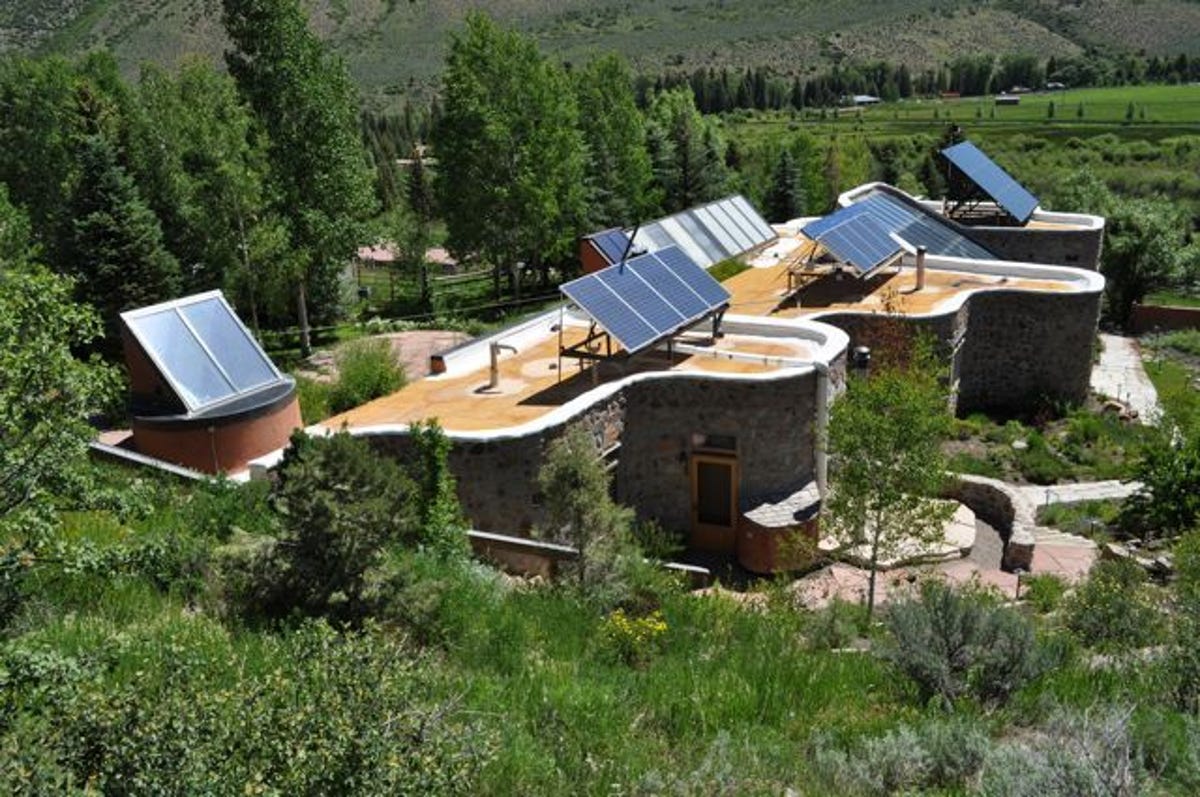Photos: Modeling the uberefficient house
At around 8,000 feet, not far from the glitz of Aspen, Colo., the Rocky Mountain Institute is putting its money where its mouth is when it comes to hyper-efficient, sustainable housing.

Amory Lovin's house
The Snowmass, Colo.-based Rocky Mountain Institute is a nonprofit dedicated to promoting sustainability in three main areas: energy, transportation, and buildings.
At about 8,000 feet, RMI founder Amory Lovins' house, which is the nonprofit's original headquarters, serves as a showcase for the kind of ultra-efficient housing that is possible today.
Though it was built years ago, it has recently been renovated and now includes a new, large set of solar panels--on top of a set of panels it already had--that allow the building to produce more energy than it uses.
The house is filled with a series of systems designed to get the most out of the building and to make the space as livable as possible.
As Lovins is apparently fond of saying, people who live in energy-efficient houses need not skimp on hot showers or cold beer.
As part of Road Trip 2009, CNET News' Daniel Terdiman toured the home.
Greenhouse from above
A chief feature of the RMI house, like that of the Earthships from which Lovins borrowed some of the concepts he used to construct it, is a large greenhouse filled with plants. Here, the greenhouse at the former RMI headquarters is seen from the roof of the building.
The greenhouse allows the south-facing room to fill with heat, maintaining a steady temperature year-round. Inside, it also has flowing water and a lot of cement, as well as dirt and plants, all of which help with the thermal mass that retains heat for six warm months and then releases it during the colder months.
Sun-tracking solar panels
The RMI house has two solar panels that are designed to follow the sun throughout the day. This means they are 40 percent more efficient than standard, south-facing panels. They're also designed to find the brightest spot in the sky during a cloudy day.
The panels depend on this tracking device to follow the sun.
Battery bank
The RMI house has a bank of batteries that store energy from the solar panels. The batteries can store two weeks' worth of power, even if there's no sun at all.
Light from Solatubes
While a lot of light comes into the RMI house through its south-facing greenhouse windows, the main walkway inside would be very dark if there weren't two Solatubes on the roof. These panels are lit from above by sunlight captured and reflected down by mirrors inside the two tubes. The effect is of lighting, but it requires no power.
Solatubes
On the roof of the RMI house are these two Solatubes. The idea is that sunlight floods through the lenses on the top and is reflected down into the house by a series of mirrors inside highly insulated tubes.
Solatube light
With the filtering cover pulled back, it is possible to see the end of the Solatubes, and the way light comes pouring out of it.
The Solatubes
The Solatubes themselves, as seen inside the RMI house. The tubes are highly insulated, and have a set of mirrors inside that reflects light from above into the house.
Water-heating panels
Most of the hot water in the RMI house comes as a result of these heating panels. Sun floods the panels, heating a series of pipes that are filled with an anti-freeze, which then, through a heat exchange process, create hot water in the building. The system produces most of its hot water, but if more is needed, or if the temperature is not high enough, the house has a supplemental, solar-powered water heater.
Inside the greenhouse
A view from inside the house's greenhouse area, which features plants, dirt, flowing water, and cement, all of which store thermal mass during the hot months and release it during the cold months.
The stream
Because the building is so well insulated, it would be extremely quiet without some form of added white noise. As a result, RMI installed a flowing stream inside the house, both as a way of capturing thermal mass and to provide the background white noise.
Heat release
During the summer months, the RMI house heats up quickly. As a way of maintaining a steady, comfortable temperature, the building features heat release panels high up in the ceiling. This is a view of the panels from the roof.
Front of greenhouse
A view of the greenhouse from the front.
Bananas at 8,000 feet
Some might think it would be impossible to grow bananas at 8,000 feet in the Rockies, but in the greenhouse, there are several banana trees, all of which serve, among other things, as thermal mass collectors.
Round rooms
Lovins felt that round rooms provide more structural stability, so many of the rooms in the building are small and round, like this library space.
Solar water heater
The RMI house's supplemental solar-powered water heater provides back-up in case the water heated by the panels on the roof isn't hot enough.
Amory's car
Lovins' car, an original Honda Insight, with the license plate, "IGO ECO."
Efficient fridge
As part of the effort to make everything in the RMI house as efficient as possible, the kitchen appliances have to meet that criteria, as well. This refrigerator has a very thick door and walls, in order to keep it well insulated.